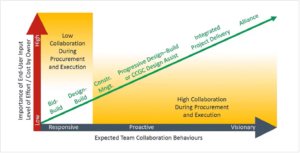
Collaborative practices
By David Bowcott
Construction Risk ManagementCollaborative Practices that Could Reduce Risk in Design-Build Contracts.
Risk allocation has been a hot topic within the construction sector for as long as I’ve been in the industry. Over the past decade this issue has climbed the ranks of the hot topic list and is now often cited as a top three issue within the construction industry. And it is a top issue globally.
The overarching position is that owners are foisting too much risk to construction contractors and design consultants, often through a design-build delivery model.
Studies conducted over the past 10 years clearly show that the delivery models (and contracts) currently being used in much of the world’s construction projects are not delivering when it comes to budget, schedule and expected benefits.
A recent Harvard Business Review article by Bent Flyvbjerg and Dan Gardner looked at a study of 16,000 major projects. Only 8.5 per cent were done on-time and on-budget. Only a half-percent of all these projects delivered the expected benefit.
Basically, 99.5 per cent of all projects failed to deliver the expected outcome of the owner. Granted, the construction industry deals with more unknown unknowns than most industries, but when 99.5 per cent of construction industry clients feel they did not receive what they had expected, there is room for improvement.
NEW MODELS; NEW EXPECTATIONS
What is being done to improve customer satisfaction within the construction sector? One hot topic is the growing use of new delivery models, including models with a much greater degree of collaboration between the three key stakeholders to the construction project: the owner, the contractor, and the designer.
The use of a more collaborative, all-stakeholder early involvement delivery model (and contract) is a great idea, however, there is one problem: These models are not being adopted at a very rapid pace globally. The overwhelming majority of project delivery models use either a bid-build or design-build framework, which are the two main delivery models that drive lower collaboration.

The spectrum of delivery models and the degree to which each model brings collaboration into the contract. (Graph courtesy of Graham Construction Group)
BUILDING OWNERS’ INTEREST
What can be done to grow the use of more collaborative delivery models? One key is for the owner community to educate themselves about the delivery models to grow comfortable with them. Education takes time, however, and perhaps a better path is to see if any of the collaborative practices housed within the other models can be applied to traditional delivery models.
The idea is to use select practices or clauses from these collaborative models to allow an owner to “dip their toe” into the collaborative project delivery model pool.
To that end, the following are some of the top practices/clauses that could conceptually be ported to the more traditional delivery models which should allow the owner a more measured approach to experimenting with collaboration within their contracts:
- Collaborative Behavioural Assessments: In the bid stage, use these collaborative behavioural assessments of potential bidders, borrowed from alliance contracts, to determine which team will work best with the owner.
- Co-locating of Stakeholders: Require key stakeholders to the contract to physically work together as the project is being carried out. Physical proximity breeds collaboration.
- Contingency Sharing: Open contingencies up to major construction stakeholders using the concepts of “skin in the game” or a “carrot in the game” to drive better collaboration and alignment.
- Conflict Avoidance Procedures: Put procedures in place that avoid conflict and bring out the issues in a solutions-oriented manner.
- Alternative Dispute Resolution: Use the power of less adversarial dispute resolution techniques.
These are just five examples of practices or clauses that could be used in traditional contractual models to allow owners to “test drive” collaborative practices within their contracts. There are many others. All construction stakeholders should be encouraged to seek out the entire inventory of collaborative practices and clauses that can be brought to projects.
Early signs from the insurance sector indicate that these collaborative practices are reducing insured losses and, by capturing and collating other performance metrics, owners could compile the necessary evidence to more fulsomely embrace collaborative contracting practices.
David Bowcott is the managing director, construction, at NFP Corp. Please send comments to editor@on-sitemag.com.





